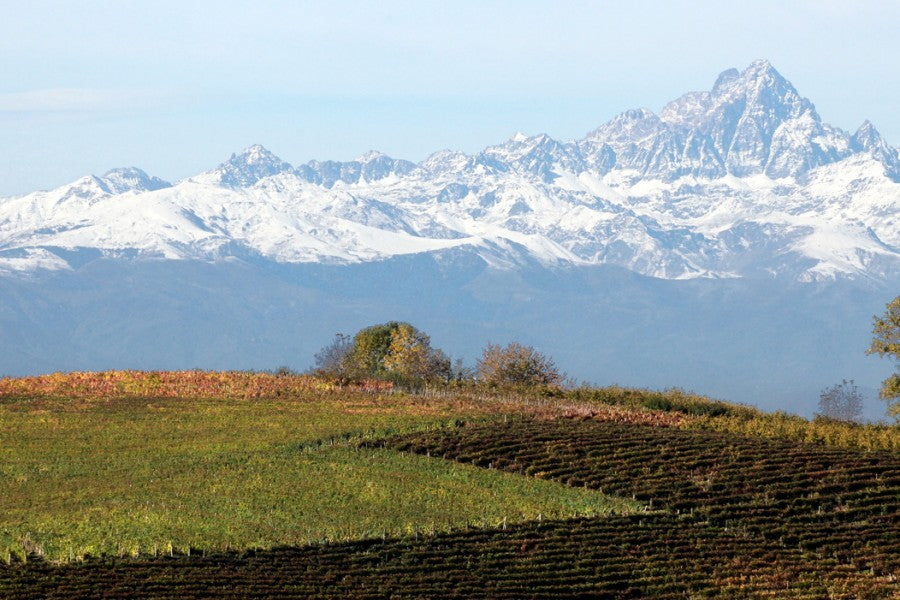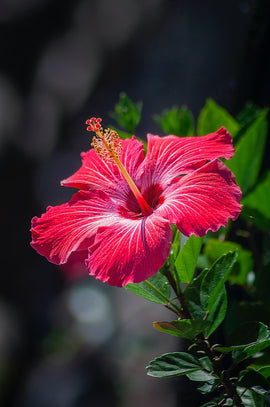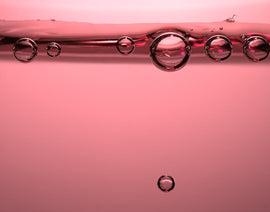Piemonte
This month we’re taking a slight detour. We just visited Piedmont in January; I wasn’t planning on returning so soon. But when our metaphorical tour bus sputtered to a halt en route to Emilia Romagana recently (I couldn’t get enough of a particular wine; fingers crossed for a future month), this most prestigious region came to the rescue with the following bottlings. Both are from local masters and feature two famous grapes with very different pedigrees qua Piedmont in particular and Italian wine more generally. For August, we’ve got a Dolcetto - the red table varietal synonymous with almost any meal in the region - and a Riesling, a noble varietal nobody goes to Italy to drink. I probably wouldn't have set out on this course, with these wines, on purpose, but as the most memorable travel experiences often emerge from the rubble of careful plans, I couldn’t be happier with where we ended up. Each is a beautiful example of an essential wine grape that, as far as I can tell, is making its debut in IWC, some seven years in. Italy is amazing.
As you may know, Piedmont, in Italy’s north western corner, is most famous for Barbarescos and Barolos - full-bodied, complex and age-requiring reds, made from the indigenous Nebbiolo grape and as prized as any in the world. Dolcetto, (which translates to ‘ little sweet one’ despite being dry) is the less heralded, but likewise-local, table red, favored with food due to its combination of fresh berry fruit, soft spice, and firm, but not overwhelming tannins. Judging by recent sales in our Noe store, Dolcettos' status as a dinner staple has been somewhat eclipsed by another Piedmont red, the softer and sometimes more approachable Barbera. This is a shame because most of the best producers in the area make an old vine Dolcetto of distinction that can be had for a fraction of the cost of more celebrated Piemont reds. Our selection this month, is from Poderi Colla, the family project of one of the most legendary and influential vintners in Piedmont (see below for more details) and it is a remarkable value; youthful and ready to drink now but with a capacious depth of field and poise exceedingly rare in bottles this affordable.
Riesling can be daunting. It blurs traditional taste binaries (dry/off-dry, salty/sweet) and covers a spectrum encompassing sparkling, bone-dry, and dessert wines (and everything in between). Flavors and aromas can recall ripe fruit (apricot, pineapple, pear) as well as synthetic products (rubber, petrol), flowers, herbs, and spices; it is classified according to bespoke German categories (Spatlese, Auslese, Kabinett) that don't necessarily tell you what the wine will actually taste like. But Riesling is also one of the true wonders of the wine world, as terroir-sensitive and more age-worthy than White Burgundy. Though the most venerated exponents generally hail from Alsace, Germany, and Austria, Italy’s various alpine terroirs provide ample potential for simpatico renderings. Aldo Vajra is a pioneer of Riesling in Italy, having planted perhaps the first vines in Piedmont in 1985 (his only rival for the title: Beppe Colla, of Poderi Colla. How’s that for kismet?) - and Vajra’s take, called Petracine to evoke roots digging into the stone, is one of the best Italian Rieslings I’ve yet come across.
Salut,
Alan Hicks -Wine Buyer - Noe Valley
|
G.D. Vajra Langhe Riesling ‘Petracine’ 2020 |
|
|
Region: Langhe, Piedmont, Italy |
About the Winery: In May 1968, 15-year-old Aldo Varja took to the streets of Turin to join the wave of student protests then cresting across the world. When his father found out, young Aldo was promptly sent to his grandparents in Barolo to keep him out of trouble for the summer, a decision that significantly altered the future of winemaking in the area. Hooked, Vajra chose a rural existence right when the countryside was being depopulated by Italy’s ‘economic miracle’. The G.D. Vajra winery was created in 1972 by Aldo and Milena Vaira, initially from vineyards planted by Aldo’s father in 1947. The winery was named for Aldo’s father, Giuseppe Domenico Vajra, because at the time Aldo was not old enough to establish the winery in his own name. Today the family has 40 hectares under vine in Barolo and other surrounding appellations. Their prized holdings in Bricco delle Viole were planted in 1949 by Aldo’s grandfather. Milena and Aldo’s three children – Giuseppe, Francesca, and Isidoro – are all involved in the family winery operation situated in the village of Vergne, which is the highest village in the commune of Barolo. About the Winemaking: Vajra Langhe DOC Riesling Pétracine is produced with the oldest vines of Riesling ever planted in Piemonte, in 1985. Vineyards are east/south-east exposed at 420-480 m asl. Its name comes from an ancient synonym of Riesling, meaning ‘the roots [into] the stone’, thus indicating it could grow well in rocky soils. The Riesling harvest takes place in the first half of September and goes on for about two to three weeks. The harvest, as well as the transport in small crates, are manually carried out to preserve the whole fruit. Gentle pressing and a brief cold settling before fermentation that lasted, in 2018, approximately 20 days. Tasting Notes: Pétracine displays citrusy aromas and tropical notes of mango and ginger. Hints of jasmine and lavender are enriched by a flinty undertone that completes the bouquet. Palate is bright and citrusy. Notes of elder flowers and slightly candied orange peel are gentle and persistent, with a mineral and sapid component that promises to evolve beautifully. |
|
Winemakers: Aldo, Milena, Giuseppe, Francesca, and Isidoro Vajra |
|
|
Price per bottle / Price per case $42 $453.6 |
|
|
Suggested Food Pairing: Pork, Squash & Root Vegetables, White Fish, Fruit Desserts, Meaty & Oily Fish, Duck, Goat & Feta Cheese, Blue Cheese. Spicy Thai takeout. |
|
|
Poderi Colla Dolcetto d'Alba DOC Pian Balbo 2020 |
|
|
Region: Alba, Piedmont, Italy |
About the Winery: Other names may be more famous internationally, but it is impossible to overstate Beppe’s Colla’s importance to Barolo as we know it today, or the esteem in which he is held locally. After graduating from the Scuola Enologica in Alba, in 1949, Beppe ran Casa Vinicola Bonardi, until 1956 when he took over Cavaliere Prunotto's firm, making it world famous at a time when the wines of Piedmont were still little known. He helped to draw up production regulations for the Alba Designated Origins, constantly striving to improve their quality. In 1961, he was the first in Barolo to commercially bottle and sell with the name of the Barolo cru on the label - the 1961 Barolo Bussia - a then-heretical act for which he was severely criticized by the local establishment, but one which forever revolutionized the winemaking in the region. In 1990, he sold Prunotto to Antinori and founded Poderi Colla with his brother Tino and his nephew Pietro. His grandniece Fredrica works there as well and together they have been producing some of the world’s finest wine ever since. Beppe passed in 2019, but the next two generations of his family continue to honor his legacy with their craft. About Winemaking: From a legendary Dolcetto vineyard in Barbaresco, owned and operated by an old friend of Beppe Colla. It would be the highest altitude vineyard in Barbaresco if the owner agreed to convert to growing Nebbiolo and classify it, but such is his belief in and dedication to Dolcetto, that he refuses. Manual harvesting, destemming, pressing, maceration with the skins for 5 to 7 days at 22°/24°, complete malolactic fermentation before winter. Stainless steel aging, bottling in spring/summer. Tasting Notes: Purplish red with violet edges. Fine nose, aromas of cherry, plum, almond, and spicy notes. In the mouth, flavors of ripe fruit, fine tannins, and great vinosity. |
|
Winemakers: Tino, Pietro, and Frederica Colla. |
|
|
Price per bottle / Price per case $23 $248.4 |
|
|
Suggested Food Pairing: Gnocchi with Red Sauce and Mushrooms. Risotto with white truffles. eggplant with tomato and garlic. Anchovies with green sauce. Any kind of Pizza. Cold Cuts and Spicy Sausages |
|
Peperoni all’Acciuga – roasted peppers with salsa verde
Great as antipasti or side dish. If you don’t want to bother with the salsa verde, you can just use finely chopped parsley and garlic instead, with a generous splash of olive oil to finish.
Ingredients
- 1kg peppers, red and yellow
- 50g of flat-leaf parsley, stems removed
- 24 anchovy filets
- 1 small garlic clove, peeled
- 2 tbsp of capers
- 50g of stale bread, crust removed
- 1 tbsp of white wine vinegar
- 150ml of extra virgin olive oil, plus more as needed
- fine sea salt, as needed
- freshly ground black pepper, as needed
Instructions
- Preheat the oven to 400 F.
- Pierce the peppers all over with a toothpick, then wrap in foil and place them straight onto the oven rack. Roast for 45 minutes, or until very tender.
- Meanwhile, make the salsa verde. Place the parsley, 6 anchovies, garlic, capers, bread, and vinegar in a food processor. Blitz while pouring in the oil in a thin stream, until you have a creamy, slightly oily, pesto-like sauce. Season to taste.
- Cut the peppers in half and remove the stem and seeds. If you like, you can remove the skin, too. Arrange the peppers on a platter, then top with a spoonful of salsa verde and garnish with one or two anchovy filets.





